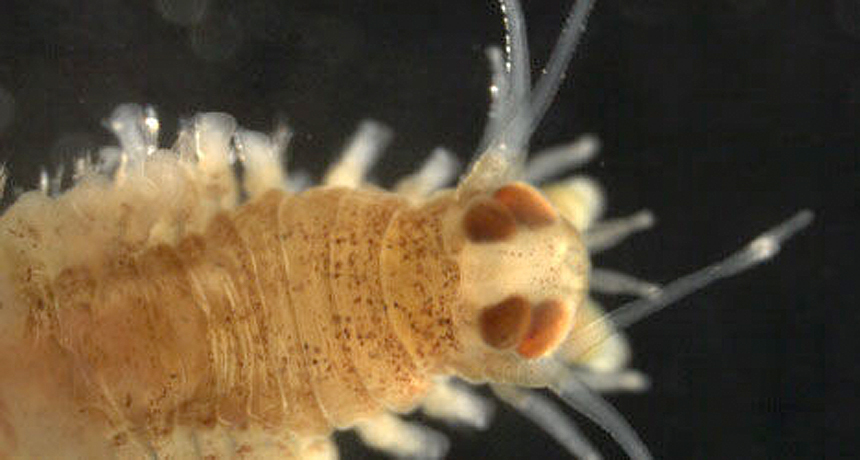Melatonin and the watery beginnings of sleep
The nightly behaviors of plankton may give insights to how sleep evolved

It may not seem like humans would have much in common with ragworms, but both species use melatonin to help control daily behaviors.
© Natural History Museum, London/eol.org (CC BY-NC-SA 3.0)
- More than 2 years ago
We all need sleep, but attaining it can be delicate. Insomniacs can’t fall or stay asleep. Travelers suffer from jetlag. Anxiety keeps people up at night. Or maybe it’s just that jackhammer running across the street keeping your eyes open. Some people turn to earplugs, dark curtains or alcohol to soothe them to sleep. But others go to the supplement aisle and pick up melatonin.
The hormone melatonin is secreted from our brains at night and helps regulate sleep. But this chemical is not restricted to humans, or even to mammals. The roots of melatonin’s role in our nightly slumbers go back much further in evolutionary history. A new paper focuses in on the role of melatonin in tiny marine creatures called zooplankton. It turns out that these animals use melatonin just as much as we do, suggesting that the origins of sleeplike behavior may lie under the sea.
“For every system and feature that makes a human or other animal today, you can ask the question: Where did it start? How did it begin? What was its first role and function, and how did it become more complex?” says study coauthor Detlev Arendt, a zoologist at the University of Heidelberg in Germany. Arendt’s laboratory has been studying the answers to these questions in the marine ragworm Platynereis dumerilii. This unassuming, centipede-like, ocean-dwelling worm produces larvae that float through the open water as zooplankton. These small larvae propel themselves up and down in the water column with movements of their cilia, slender, hair-like appendages that protrude out from the organisms.
This rise and fall takes place on a nightly basis. As dusk arrives, zooplankton propel themselves up toward the surface. At the night and into the dawn, they sink back down into deeper water. The biological mechanisms underlying this daily routine might also be the basis of other circadian rhythms, including our own.
“[The larva is] pretty far away from us evolutionarily,” Arendt explains. “So whatever characteristics it has that are conserved between it and vertebrates like us has been present in all other animal groups as well.” He and his group were particularly interested in the potential role of melatonin in the larvae. In previous studies, he and his laboratory had found light-sensitive cells in the middle of the zooplankton’s developing brain. The cells were similar to cells in the human pineal gland. In people, the cells produce melatonin and help to control circadian rhythm. So Arendt’s group became interested in whether the cells in the zooplankton larvae might also express melatonin and have a similar function.
Maria Tosches, an evolutionary and developmental biologist at the University of Heidelberg with Arendt, set out to determine whether these ragworm larvae synthesized melatonin in their tiny brains, and if they did, if it was involved in their nightly movements up and down the water column. Melatonin also soaks up unpaired, reactive ions that can cause damage to DNA or proteins in a cell. So its mere presence in larvae would not be enough to determine the cause of the zooplankton’s evening rhythms.
She found that the larvae not only produce melatonin in their brains, they also use it to control their evening rise and fall in the ocean. At night, melatonin rises, and the openings through which cilia project into the water close. With the cilia retracted, the larvae sink lower in the water. An extra dose of melatonin, even during the day, decreased the number of cilia working away at the water. Conversely, blocking the receptors for melatonin at night prevented the cilia openings from closing, leaving more cilia in the water to propel the plankton about . Tosches, Arendt and their colleagues published their findings September 25 in Cell.
Tosches showed the hormone activates two specific neurons in the larval ragworm’s brain, spurring the cells to fire in rhythmic bursts. These neurons release the chemical messenger acetylcholine, and the signal increased ciliary closure. As the cilia close, the zooplankton sink.
So melatonin played an important role in regulating the daily behavior of the ragworm larvae, just as important a role as the hormone plays in our own internal clocks. But this sinking is not quite plankton sleep. “It is more complex than that,” explains Tosches.
While the larvae don’t sleep in the traditional sense, their nightly rise and fall might be the first instance of something “sleep-like.” “All phenomena have a first instance when they occur,” he explains. “We know that organisms came from the ocean, so it’s possible we are finding and characterizing the first niche where sleep played a role.”
The finding highlights what we can learn about how we came to be from seemingly humble model species. “Life evolved in the ocean, but unfortunately we cannot go back 600 million years and watch what happened,” Tosches says. “But studying marine ecology and neurobiology can still tell us something about where our brains come from.”






